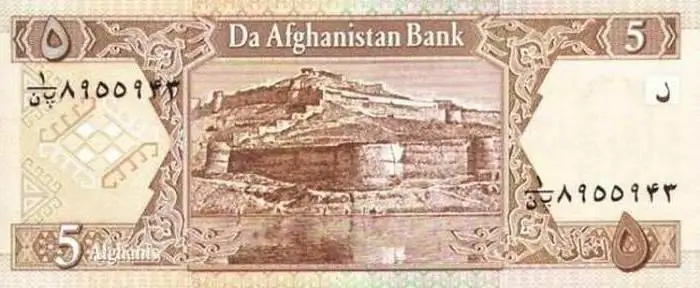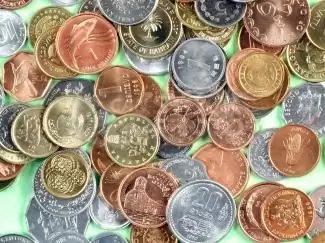2025 Author: Howard Calhoun | [email protected]. Last modified: 2025-01-24 13:10:45
The national Omani currency is the Omani rial, which is designated as OMR on the international currency market.
Description
This currency is the state currency in Oman. It can be found on the map if you look at the Arabian Peninsula, in the southeastern part of which this Arab state is located.

One riyal of Oman is divided into 1000 Omani baize. To date, the currency of Oman is quite expensive, stable and very freely convertible monetary unit. This is largely due to the fact that the sultanate is among the oil exporting countries along with other oil-producing countries of the Persian Gulf, including Saudi Arabia, the United Arab Emirates, Qatar and Kuwait.
Thanks to petrodollars, Oman managed to develop its economy quite well, thereby raising not only the standard of living of its citizens, but also stabilizing the national currency.
A Brief History
In the 19th century, Maria Theresa thalers and Indian rupees circulated on the territory of modern Oman, since there was no national currency in the country, and the country itself did not exist at that time.

Then, the Dofari and Saidi rials were used, which were used asstate currency in Oman until 1970. Between 1959 and 1966, the Persian Gulf rupee was also in circulation. Moreover, several currencies were in use at the same time.
In 1966, the Indian rupee depreciated greatly, so the Gulf countries, which had used the rupee as a monetary unit on their territory until that moment, were forced to abandon its further use.
In 1970, the Saidi rial became Oman's sole national currency. Its rate was equal to the rate of the British pound sterling.
In 1974, the Omani rial was put into circulation, becoming the only currency in the country. Riyal Saidi was exchanged for Omani at the rate of one to one. This banknote is used in the country to this day.
Coins
Today, change coins are officially used in the Sultanate of Oman, which are called baizes. There are a thousand of them in one rial. In circulation are coins in denominations of five, ten, twenty-five, fifty and one hundred bytes. The most commonly used of these are the ten, twenty-five and fifty bize coins.

Usually, Omani coins are made of steel clad with either bronze or cupro-nickel.
Banknotes
Today, in the territory of the Sultanate of Oman, paper banknotes are used in denominations of one hundred and two hundred baize, as well as one-fourth, one-half, one, five, ten, twenty-five and fifty rials.
All inscriptions on the obverse of banknotes are written in Arabic. Also there you cansee the portrait of Sultan Qaboos bin Said, who is not just a legendary figure and ruler of Oman, but also, in fact, the founder of this state, since he united the Imamat of Oman and the Sultanate of Muscat into a single state of Oman.

The reverse side of the banknotes depicts scenes from the life of Arabs, architectural heritage, as well as representatives of the animal world. All inscriptions depicted on the reverse of banknotes are written not in Arabic, but in English.
Rial: exchange rate
The Omani currency is one of the most expensive in today's global foreign exchange market. This is due to many factors that affect OMR quotes.
First of all, the high cost of the currency is associated with huge financial injections into the economy of Oman thanks to petrodollars. The second point that affects the high cost of this currency is the stability of this currency, which in turn is ensured by a stable political and military situation in the country since the 70s of the XX century.
Today, the exchange rate of the rial against the ruble is approximately 148 rubles for one Omani rial. Accordingly, for one ruble you can get no more than 0, 007 rials.
Based on this, it becomes obvious that the currency of Oman is worth much more than the US dollar or the European currency. For one American dollar, you can get about 0.38 OMR, therefore, one riyal contains more than two and a half dollars.
For a euro you can get about 0.43 rials, that is, for one rial you can getabout 2, 3 euros. Thus, it turns out that the Omani currency is much more valuable than any European or American one.
It is worth noting that the Omanis are very proud of their national money, so it is not worth going to this country, taking with you rubles or another unpopular currency in this country. In Oman, you can only exchange US dollars, euros and British pounds. It will also be easy to exchange Indian rupees.
All other monetary units, and even more so Russian rubles, are almost impossible to use in Oman. By the way, exchange offices in the country work only in the first half of the day, until unbearable heat sets in. Then a break. And from approximately 16:00 to 20:00 they are again open for work. Not a single exchange office is open on Friday.

Oman is a modern and rich country, so there are no problems when paying with plastic bank cards. Debit and credit cards are accepted in almost all stores, cafes and other organizations.
Conclusion
The currency of Oman, like the Sultanate of Oman itself, is stability and firmness. As mentioned above, the Omanis are very proud of their national currency, because the rial symbolizes the independence, stability and strength of Oman.
Thanks to high income, oil and gas we alth and influx of foreign investment, Oman, on the map of which you can find many oil fields, has managed to create a powerful and strong economy, as well as a politically stable state. This is the main reason for such a highthe value of the national currency of this country and its stability over the years.
Even against the background of other national currencies of the Arab oil-exporting countries, the currency of Oman stands out strongly. First of all, because it costs much more on the world currency market than, say, the UAE dirham or the Saudi Arabian riyal.
The difference in the value of the currencies of states neighboring Oman can be 5-6 or even more times. This difference is primarily due to a more stable political situation in the country and greater openness to foreign tourists and investment.
Recommended:
Currency borrowers. All-Russian movement of foreign currency borrowers

At the end of last year, an all-Russian movement of foreign currency mortgage borrowers was formed. This was due to the sharp devaluation of the ruble, which made it almost impossible to service loans of this type
The currency of Saudi Arabia is the Saudi rial

The national currency of Saudi Arabia - the riyal (riyal) - is the official currency of the kingdom located on the Arabian Peninsula. For a long time, this territory did not have its own monetary unit; gold and silver items from European countries were in use
Currency of Oman: Rial

This article will focus on the Omani rial - the national currency of the state of Oman. The material will introduce the reader to the history of the currency, its appearance, the exchange rate relative to other monetary units and other interesting facts
The currency of Afghanistan: the history of the currency. Curious information about the currency

Afghan currency Afghani has almost a century of history, which will be discussed in this material
What is a currency? Russian currency. Dollar currency

What is the state currency? What does currency turnover mean? What needs to be done to make the Russian currency freely convertible? What currencies are classified as world currencies? Why do I need a currency converter and where can I find it? We answer these and other questions in the article

